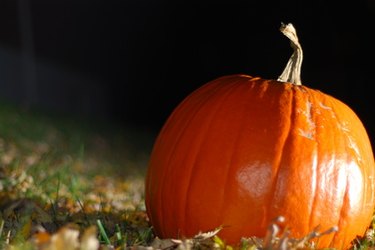Things You'll Need
Row covers
Insecticide containing pyrethrins or carbaryl
Sand
Commercial slug bait (optional)
Insecticide with the active ingredient bifenthrin
Cabbage leaves

Pumpkin, a warm-season vegetable and a member of the squash family, has uses that are both ornamental and culinary. Hand-carved jack-o'-lanterns serve as colorful Halloween decorations, while the flesh of the pumpkin is used in pies, soups and breads; the roasted seeds can be a nutritious snack. Pumpkins can be grown in a home garden with little difficulty, but their survival is sometimes threatened by a variety of insect pests that not only feast on the plants, but transmit diseases. If you have bugs on your pumpkin plants, it's important to attack them right away; adult insects are more difficult to kill than the larvae. With the proper treatments applied at the proper time, you should be able to banish the bugs from your pumpkin plants.
Step 1
Examine your pumpkin plants closely--especially when plants are at the seedling stage or first flowering--for the presence of the striped cucumber beetle, which is greenish yellow with black stripes, and about 1/4 inch long. This pest not only feeds on young plants, but spreads the serious disease bacterial wilt.
Video of the Day
Step 2
Protect the pumpkin plants from cucumber beetle by using row covers. For major infestations, spray with a commercial insecticide. According to the Cornell University Extension website, either pyrethrins or carbaryl can be effective on cucumber beetles.
Step 3
Spread a layer of sand under the pumpkin fruits--allowing it to extend outwards around the pumpkin for several inches-- to discourage snails and slugs, which don't like crawling over abrasive surfaces. Alternately, you can use commercial slug bait.
Step 4
Use an insecticide containing carbaryl at the first sign of vine borers, which appear when the vines begin to spread out. Identify vine borers by looking for caterpillars with brown heads and whitish bodies, beetles with black and red wings, and small holes in the foliage and fruits. You can also mound up soil around bases of vines to promote outward root growth that will take the stems beyond the range of the borers.
Step 5
Spray pyrethrins or carbaryl at the bases of the plants at the first sign of squash bugs--gray-brown insects that lay masses of red-brown eggs on leaves and stems in midsummer. Squash bugs cause withering, bronzed-looking leaves and rotting fruits, and can decimate your pumpkin patch.
Step 6
Use a foliar--or leaf--insecticidal spray to kill the squash bug nymphs as soon as you see the eggs. According to the University of Illinois Extension website, a registered insecticide sold under the name Capture is effective on nymphs, but must be applied when the nymphs are still small.
Step 7
Set out several large cabbage leaves near the pumpkin patch; they will attract large quantities of squash bugs, which you can then destroy.
Tip
Till the soil completely after you have harvested the pumpkins to prevent pests from overwintering.
If you use row covers to protect your pumpkins, remember to remove them when the plants flower so that pollination can occur.
Video of the Day